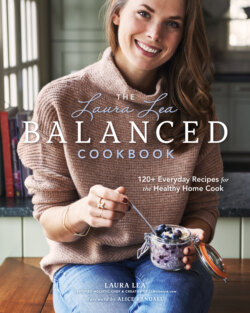Читать книгу The Laura Lea Balanced Cookbook - Laura Lea - Страница 36
На сайте Литреса книга снята с продажи.
ОглавлениеHEALTY EATING ON A BUDGET
Follow the Dirty Dozen for organic selections.
I understand that organic food can get real
expensive real quick. As a result, I follow the
Environmental Working Group’s list called
the Dirty Dozen. This list includes fruits and
vegetables that are highest in pesticide
content. I try to buy organic versions of the
Dirty Dozen items, such as berries, leafy greens,
and apples. Visit EWG’s website (EWG.org) for the updated list.
Buy seasonal and local produce. Produce is
generally cheaper when it is in season, so look
for items from local or regional farms. Buy in bulk.
Chop fruits and vegetables into smaller pieces,
place in zip-top storage bags, and freeze. Use
as you would pre-packed frozen produce.
Check for sales and choose recipes accordingly.
Stay tuned-in to the sales going on at your
grocery stores. Make a list of the whole-foods
items on sale, then see which recipes in my book
(or another book, I guess) use those items. Again,
stock up and freeze anything that can be frozen
(see page 53 for help with that).
Ditch bottled drinks for homemade options.
My husband and I get bored with plain water,
and as much as we love seltzer and kombucha,
the cost of bottled drinks adds up quickly. As an
alternative, soak fruit in a pitcher of filtered water
overnight to infuse the flavor. I also do this with
cucumber and mint or basil. You can also try my
Cleansing Raspberry Ginger Water (page 86) or Workout Water (page 89).
Eat eggs. Eggs are inexpensive and incredibly
nutrient-dense. Always keep some in the fridge and
enjoy them as your protein in any meal or snack. Stir
a raw egg into some cooked grains over a little heat
for a quick “fried rice.” Make an easy egg salad
with a few hard-boiled eggs, a dollop of mayo, a
smaller dollop of Dijon mustard, and pinches of salt,
pepper, and onion powder. Delicious!
Visit the frozen section. There is nothing wrong
with frozen fruits and vegetables, so fill up your cart
and freezer and feel good about it. I almost always
use frozen organic kale and spinach in my green
smoothies. Not only is it cost-effective and longer-
lasting, but it makes for a creamier texture and
better flavor. Most produce is frozen right when
it’s harvested, so it can have even more nutrition
than some items that have traveled a long way
to get to you.
Get slow cooker–friendly. Cheaper cuts of meat
are generally tougher, but they can break down
beautifully in a slow cooker. Add a few pounds
of some of these tough cuts with enough water
to cover halfway, throw in some seasonings, and
let it cook for hours. Check out my Slow Cooker
Indian Butter Chicken (page 238) for an example.
Condi-meat. Say what?! Think of meat as a
condiment, not the centerpiece of each plate.
Make sure you’re offering plenty of vegetables
with your entree and encourage family members
to fill up on those first. If you can ditch the notion
of meat as the main event, it will save you some
serious bucks in overall quantity consumed.
continued on next page
